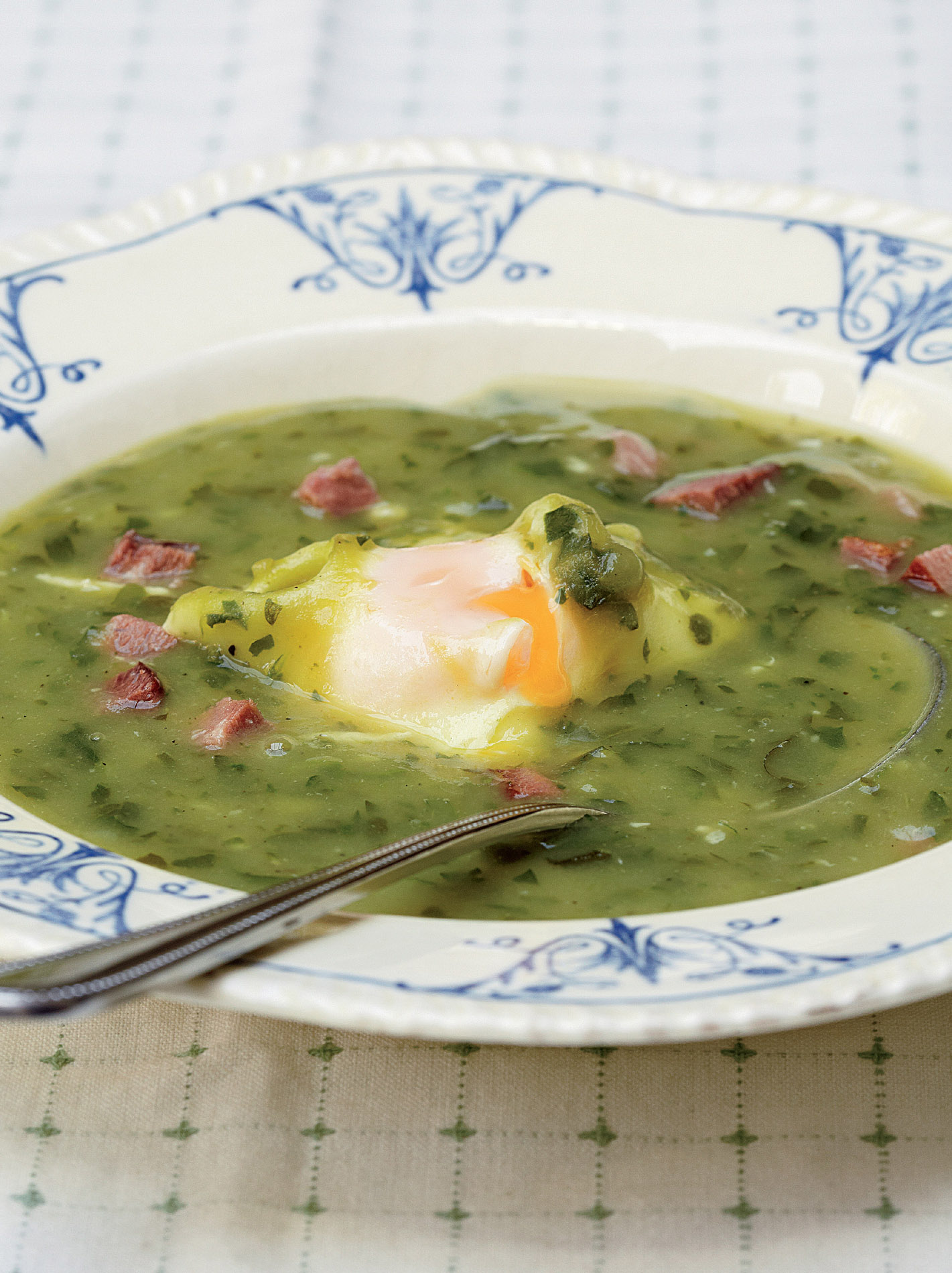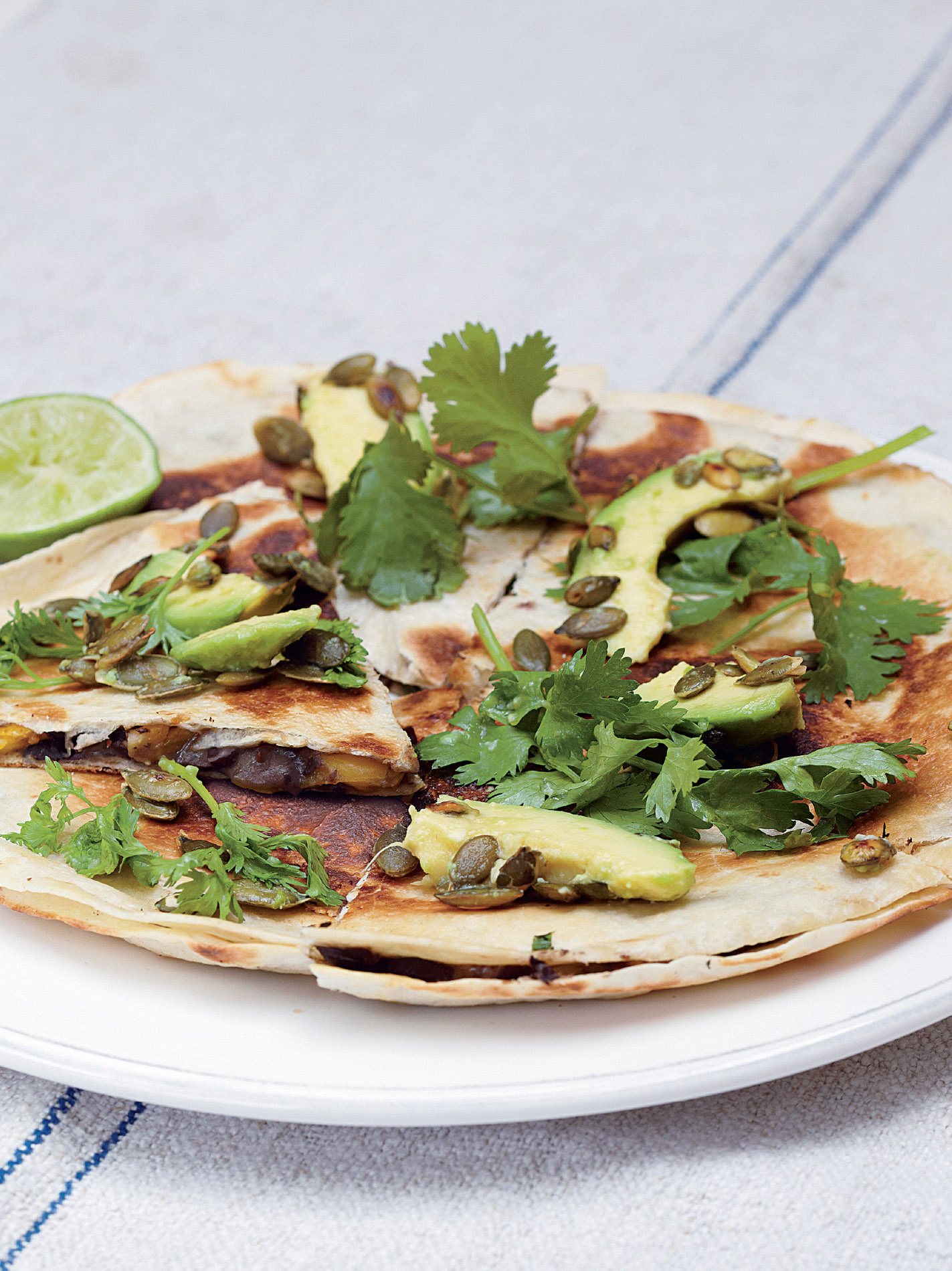SOUPED-UP SOUPA
(POTATO AND PARSLEY SOUP WITH A POACHED EGG)
serves: 4 preparation time: 20–25 minutes cooking time: 25 minutes
Soup is my default lunch. My screensaver, if you like. Left to my own devices, at home, I’ll go for soup at lunchtime.
I don’t always have home-made, the ready ones are a good enough base these days, but I can’t help playing with them – mixing tomato with lentil, adding a few bits and bobs like croutons, cottage cheese, pesto and chilli (but not all together). But on cooler days, I tend to make my own much more, and this recipe takes the simple to the special with minimal effort.
- 1 heaped tablespoon butter
- 1 leek, halved lengthways, finely sliced and washed
- 2 cloves of garlic, peeled and roughly chopped
- 3 potatoes (about 600g), peeled
- 700ml light chicken or veg stock
- salt and pepper
- 40g flat-leaf parsley, roughly picked and washed
- 4 eggs
- 1 smoked duck breast (or 2 thick slices smoked ham)
Put a saucepan on a high heat with the butter and when it’s melted, tip in the leek and garlic. You don’t want the leeks to colour, so once they’re sizzling nicely, turn the heat down and put a lid on.
Cut the spuds into 2cm thick slices, stack up a few at a time, cut them into chip shapes, then line them up and chop into approximately 2cm to 3cm dice. Stir these into the pan then pour in the stock. Season with salt and pepper, turn the heat up and pop a lid on. Boil fast for 12–15 minutes until the spuds are cooked.
Ladle half of the soup into a blender and pulse until smooth. Add the parsley then pour in the rest of the soup. Blitz for a minute till the parsley is coarsely chopped – I think it looks nice if there are still visible bits of green – then pour everything back into the pan, lid on, over a medium heat.
Taste your soup – it will probably take a bit more salt and pepper at this stage. When you see it starting to steam and little bubbles just beginning to appear, crack the eggs in as far apart as you can, but not right at the edge, and put the lid back on.
Cut your duck breast in half. Slice one half, stacking the slices, and then cutting into matchsticks. Line up your matchsticks and chop again to make small dice (you can freeze the rest of the duck breast or keep it in the fridge for sandwiches/salads). Share these among four warmed soup bowls.
After your eggs have been in for 4–5 minutes, gently lift them out with a slotted spoon, taking care to release them if they’re stuck to the bottom of the pan. Put one on top of the duck in each bowl and ladle the soup around.

BUBBLE AND SQUEAKP
WITH BACON AND EGG
serves: 4 preparation time: 5 minutes cooking time: 20 minutes
If one dish were to be chosen above all others to represent thrifty eating it would have to be bubble and squeak. Totally British and slightly mad, this is traditionally a mixture of potato and cabbage (or some other brassica), lightly burned in a frying pan. This burning on of a crust is very important to the flavour of the finished dish.
For some reason bubble and squeak never tastes the same when it is assembled from raw ingredients. It really does need to be made with leftovers. Cold mash and Brussels sprouts (my personal favourite) are what is needed for a decent splodge of bubble – who says the English are eccentric?
One final point: I have often been irresistibly drawn to this dish on gastro pub menus, when it’s served with something delicious like wood pigeon or wild boar sausages. Lovely … but then I am miffed to find the bubble and squeak coming coated in breadcrumbs, done up like a fishcake. This is far too fancy … probably something those continental types would do! Keep it simple.
- 60g butter
- about 20 cooked Brussels sprouts, cut in half
- about 8 tablespoons cold mashed potato
- 4 eggs
- 4 rashers of bacon
Heat a frying pan and melt half the butter. Toss in the sprouts and cook them until they start to colour on the outside. Be brave at this point and allow them to go a really dark brown – the middles will remain soft and sprout-like.
Add the mash to the frying pan. I find it easiest to do this with my hands – that way you can scatter it across the whole of the pan, which makes the mixing in easier. So, mix the contents of the pan and squelch everything down so it covers the base. Now add the remaining butter by breaking off little pieces and allowing them to melt around the edges of the pan. Don’t move the potato and sprout mix. Underneath it is caramelizing, even burning, which is exactly what it should be doing. After about 3 minutes scrape and mix the potato and sprouts. Try to get the burnt bits back into the centre of the mixture, so that you have a fresh surface colouring underneath. Continue to do this until your mix is well coloured and slightly crispy.
At this point fry your eggs in a separate pan and grill your bacon, because you are moments away from serving up a money-saving British classic.

BRUTUS SALADA
serves: 2 preparation time: 15–20 minutes cooking time: 12–15 minutes
There is absolutely nothing wrong with a Caesar salad – they’re just seen as being a bit boring now, and no one does them justice at home because they can’t be bothered to make the dressing. Enter Brutus – punching all the flavour buttons that his old boss had before him, but to a new tune.
With the lettuce, you just want to use the crisp, inner leaves for this salad. The outer layer can be saved for Petits Pois à la Française on p.181.
Pomegranates are very Roman and the redder they are on the outside, the better the colour inside. As I’m sure you’ve already concluded, their seeds and juice against the creamy dressing represent blood on toga …
- a hunk of bread (80g), whatever kind you have around, preferably white, old is good
- 2 cloves of garlic, finely chopped
- 4 tablespoons extra-virgin olive oil
- salt and pepper
- 70g lardons
- 100g feta
- 3 tablespoons Greek yoghurt
- juice of ½–1 lemon
- 1 pomegranate
- 350g cos, baby gem or romaine lettuce
Preheat your oven to 180ºC/160ºC fan/gas mark 4. Cut the bread into rough 2cm chunks and put them on an oven tray. In a small bowl, mix the garlic with a tablespoon of extra-virgin olive oil and some salt and pepper. Drizzle this over the bread chunks and scrunch with your hands so all the pieces are coated with garlicky oil. Stick them in the oven on a baking tray and cook for 12 minutes, shuffling halfway through.
Fry the lardons in a small frying pan over a high heat, stirring regularly so they get an even golden-brown colour. After 5 minutes they should be shrunken and crisp. Lift them out with a slotted spoon on to kitchen roll.
To make your dressing, roughly crumble up the feta into small lumps and mix with the yoghurt, the rest of the extra-virgin olive oil, the lemon juice and some pepper.
Cut the pomegranate into quarters and dig out the seeds over a bowl with your fingers. Make sure that there is no white pith because it’s very bitter. Slice your lettuce into wide ribbons and give it a wash and dry.
In a large bowl, toss the lettuce with the croutons and dressing. Divide these between two plates or shallow bowls, then scatter the bacon bits and pomegranate seeds over the top.

FRESHLY BAKED BREADP
(AND CHEESE)
makes: 3 loaves preparation time: 15 minutes, plus proving cooking time: 40 minutes
I feel a rant coming on! Can you call yourself a cook if you can’t bake bread? I don’t think so. Baking bread really is one of the most basic, universal processes going. But things have changed in the last few years and nowadays most people don’t even buy their bread from a baker any more, preferring to go to the supermarket.
The bread section in my local supermarket is a stunning array of loaves from around the world, all apparently ‘baked on the premises’. Unfortunately, when I lurch forward uncontrollably, anxious to bag a wonderful-looking ciabatta or focaccia or farmhouse loaf, I am always rocked right back to my senses at the merest touch of this springy, airy, long-life loaf ‘stone baked’ right here on an industrial estate. OK, real bread lasts only a day or two before it’s got toast written all over it, but that’s fine. It’s so good I’d be surprised if you had any left after two days.
This is my recipe for a crusty white loaf, which is a good starting point for the novice baker. As you learn the joys of bread making, you will undoubtedly ditch the recipe for a more intriguing one, and in turn you will probably start considering buying a wood-burning oven and all sorts of baker’s equipment! But that’s later on. Right now you simply need to get started.
A quick word about ingredients. Yeast is a living organism that is most active at around 35 degrees centigrade. It will happily live on in your fridge for about two weeks or you can freeze it. It can be obtained mail order or by begging a kindly baker (or supermarket bakery counter) to give you a little. Alternatively you can buy a packet of the dry stuff and follow the instructions.
The type of flour makes a huge difference. Strong flour has a high gluten content, which means it’s ideal for bread making. However, even strong flours vary, so try a few different ones. I personally use French strong bread flour known as T55 but you can replace it with a brown or whole-grain flour if that’s your thing. If you wish to increase your choice of flour beyond the supermarket selection, go online and see what you can find.
The recipe on the next page makes three loaves. They will freeze quite happily, so never make a single loaf.
- 1kg T55 strong white bread flour
- 550ml water
- 20g fresh yeast
- 15g salt
- a dish of salted water
- a little extra flour for dusting
If you have a food mixer with a dough hook, life is about to take a turn for the better! Bung the flour, water, yeast and salt into the bowl, attach the dough hook and switch on. If you leave the mixture turning on the slowest setting, you will quickly have a dough. Then just allow it to keep turning, as you are now ‘kneading’ the dough. After about 4 minutes of kneading, switch off the machine. Cover the bowl with a damp cloth or some cling film. Let this sit out at room temperature for about 1 hour, by which time the dough will have doubled in bulk. This is known as ‘proving’.
For those of us without a fancy food mixer the only consolation is that we are about to burn a few calories, because bread making à la methode traditionelle is a fairly strenuous affair. In a large bowl mix the flour, water, yeast and salt together. The first time you will probably try using a wooden spoon. The second time you won’t bother, because you will realize spoons of any sort are utterly useless – the baker is a hands-on kind of guy! Once the dough has formed a large ball, turn it out on to a floured work surface. In one motion, push the base of the palm of your hand into the dough while pushing it forward to stretch it, then lift the front edge of your dough and bring it back over to form a ball once more. Believe me, this is much easier to do than explain! Work the dough quite vigorously and quickly for at least 10 minutes. Then put it back in a large bowl and cover it with a damp cloth or some cling film. Let this sit out at room temperature for about 1 hour to double in size. While you’re waiting, I’d recommend you have a cold drink and look up the price of a decent food mixer on the internet!
Next comes the ‘knocking back’ stage. Simply punch your aerated dough in the bowl a few times – this will knock a little air out of it, so expect it to sink back slightly. Then turn the dough back out on to a floured surface and cut it into three even-sized chunks. Shape each of them into an oval loaf by gently flattening the dough and folding the edges back underneath. The shaping of loaves takes a little practice and experience, but there is no problem with this as even the most amusing shapes can still be baked and will taste fantastic.
Place your loaves on an oiled and floured baking tray at least 20cm apart. Paint the surface of your loaves with the salted water and then dust them liberally with flour and slash them with a knife lengthways about 5mm deep. Leave them to prove once more – about 15 minutes should be fine.
Meanwhile, preheat the oven to 240ºC/220ºC fan/gas mark 9. Put your bread in the oven and set a timer for 8 minutes. When the timer goes off, open the oven door for 2 minutes to let the heat escape, then reduce the heat to 190ºC/170ºC fan/gas mark 5, close the door and cook on for 30 minutes.
Turn the baked bread out on to a cooling rack until you can’t hold back any longer. Serve while still warm with unsalted butter and your favourite cheese – mine is an aged Comté, by the way.
One final thing: it’s possible to save a fortune by making all your own bread, so if you intend to make it on a regular basis I would recommend a simple step that will give you a better-tasting loaf. Each time you make some dough, cut off about 10 per cent and put it in the fridge. The next dough you make should have this lump added at the initial mixing stage. Keep this system rolling over so you always have a piece of dough ready as a starter for the next session.


SPICY BLACK BEAN QUESADILLAA
makes: 2 big ones, for 2 hungry people preparation time: 15–20 minutes cooking time: 15 minutes
Down Mexico way, one of the things that makes their food some of the most yum-a-licious on the planet is the combination of cooked and spiced versus fresh and zingy.
You may not choose to make this on your own for lunch or supper, but for a quick-and-easy mate-drops-round or family weekender, it’s a bit of a winner – just maybe cut the spice down for the kids.
Freeze the tortillas and take out as you need.
- 1 x 400g tin black beans
- ½ teaspoon ground cumin
- ½ teaspoon dried oregano
- 1 teaspoon dried chilli flakes
- 2 spring onions, sliced
- 1 pepper, diced into 1cm cubes
- 80g Cheddar, grated
- salt and pepper
- 4 large (25cm) flour tortillas
- 1 clove of garlic
- 2 tablespoons light oil
- a handful of coriander, washed and picked
- 1 ripe avocado, peeled and cut into rough chunks
- 2 limes
- 2 tablespoons pumpkin seeds
In a bowl, mix the drained black beans, cumin, oregano, chilli flakes, spring onions, pepper and grated cheese. Give this a heavy season with salt and pepper, then scrunch it all together in your hands for a couple of minutes, breaking up all the beans as you go.
Lay the tortillas out on your surface, cut the clove of garlic in half and rub the cut side vigorously all over the tortillas. Halve the bean mixture between two of the tortillas and spread out to within a centimetre of the circumference. Sit the other tortillas on top (garlicky side down) and gently push down to compress.
Put a frying pan, big enough to hold a tortilla, on a low to medium heat, pour half of the oil into the frying pan and flop in one of your quesadillas. Give it 3–4 minutes on each side, pushing down from time to time with your spatula/palette knife/fish slice. Flip the tortilla over, using your hand as a guide, and cook the other side, then turn it out and do the same with the other one, pouring in the remaining oil in between.
In a small bowl, toss together the coriander, avocado, juice of one of the limes and a pinch of salt.
When you have lifted the second tortilla out of the pan, throw the pumpkin seeds into the pan and toast for 1 minute until golden, then tip them into the bowl with the coriander and avocado.
Cut your quesadillas into six and finish with a scattering of the coriander, avocado and pumpkin seeds on top. Serve with half a lime on the side. Eat hot.

MORE THAN SIMPLY A STEAK SANDWICHP
serves: 1 preparation time: 15 minutes cooking time: 6 minutes
A few moments ago, when I met our post lady (woman, girl, person … I get so confused) in the street, I asked her what her favourite sandwich was. She replied that it was cheese and tomato. Actually, she only gave me this information after satisfying herself that I was not (a) insane and (b) about to ask her out for dinner. Anyway, the point is that sandwiches have been firmly on my mind. They are simply the perfect one-stop meal, especially for lunch. If you get the filling right – say, some slices of Serrano ham, rocket and a drizzle of olive oil – they are nutritiously balanced, filling and delicious.
While I probably make two or three sandwiches a week, it’s a little less often that I treat myself to the unrivalled joy of a steak sandwich. Traditionally made with a flattened sirloin steak known as a minute steak, they can prove a rather expensive treat. However, this one uses a cut called bavette, a little culinary treat that the French have kept to themselves … up to now. A bavette will set you back a lot less than sirloin, or rib-eye for that matter, but one word of warning – don’t overcook it. Medium-rare at most.
- 200g bavette steak
- olive oil
- 2 slices of your favourite bread
- a few slices of tomato
- a few slices of red onion
- some shredded lettuce
- a good dollop of mayonnaise
- a dollop of horseradish relish
- a dollop of Dijon mustard
I definitely think that this steak is far tastier if done on a barbecue or in a ribbed grill pan, but assuming that neither is available just pick your heaviest non-stick pan. The steak requires no advance preparation at all, but if you are going to cook it rare or medium-rare, take it out of the fridge for 15 minutes prior to cooking so that it’s not fridge-cold.
To cook your steak, heat the pan until it is so hot it’s almost smoking, then give the steak a wipe – no more – of olive oil and cook it for about 6 minutes in total, turning it three or four times. Then rest the steak for up to 5 (unbearable) minutes while you prepare the rest of the sandwich.
The first thing to do is to toast the bread. Wipe your chosen slices with olive oil and cook them until they are crispy on the outside but still a little soft in the middle. If using the grill pan or a barbecue, they should also take on the characteristic charred markings. On one cooked slice lay your tomato and red onion topped with a generous amount of lettuce which has been mixed with mayonnaise. Now slice the steak into long slices about 2cm thick and lay them on top. Add the horseradish and mustard, or serve them on the side. Close the sandwich, cut in half, open an ice-cold bottle of beer and enjoy.

TROLLEY-BASHING
NOT HAVING ENOUGH TIME IS THE DEFINITION OF CONTEMPORARY LIVING, AND SOME CLEVER MANUFACTURERS OUT THERE HAVE WORKED OUT WAYS TO APPEAL TO THIS FACET OF OUR LIVES.
OF THE TOP CRIMES THAT YOU CAN FIND ON THE SHELVES OF YOUR SUPERMARKET, SOME ARE RELATIVELY NEW (THINK PRE-COOKED RICE, OR READY MASH) AND OTHERS ARE LEFTOVERS FROM TIMES WHEN FRESH INGREDIENTS WERE HARDER TO FIND AND STORE (LIKE PRE-SQUEEZED LEMON JUICE).
I’M ALL FOR MOVING THE PLANET FORWARD BUT THERE ARE SOME PRODUCTS AVAILABLE TO BUY NOW THAT ARE, WITHOUT DOUBT, A STEP BACK.
BEING ABLE TO KNOCK UP YOUR OWN DRESSING CANNOT BE DESCRIBED AS HARD, AND YOU CAN’T BE SO BUSY THAT YOU DON’T HAVE 15 MINUTES TO MAKE A TOMATO SAUCE. DON’T BE FORCED INTO BUYING A JAR OF PASTEURIZED RAGÚ THAT WAS COOKED MONTHS AGO, PROBABLY IN A GALAXY FAR, FAR AWAY … SANDWICHES ARE A CASE IN POINT.
DEEP DOWN INSIDE YOU KNOW THESE ARE NOT SENSIBLE CHOICES, SO BEFORE YOU PLEAD IGNORANCE AS TO WHAT IS AND ISN’T OK TO BUY, HERE ARE A FEW HEADLINE THOUGHTS, AND I RECKON YOU CAN WORK THE REST OUT ON YOUR OWN.
You really aren’t doing yourselves any favours if you buy …
- ◦ Pasta sauces
- ◦ Vinaigrettes
- ◦ Ready mash
- ◦ Prepped fruit and veg, including celery/romaine hearts, peeled spuds, pre-cut fruit
- ◦ Grated cheese
- ◦ Cooked rice, polenta or couscous
- ◦ Pre-grilled burgers/pre-roasted chicken
- ◦ Breadcrumbs and croutons
- ◦ Pre-squeezed lemon juice
- ◦ Cooked cocktail sausages
- ◦ Apple/mint/tartare sauce
- ◦ ‘Fresh’ stock
- ◦ Cheat’s pre-prepared garlic and ginger
- ◦ Prepped salads (they go off much faster)
- ◦ Marinades
- ◦ Smoothies
- ◦ Cake mix and pre-made icing
- ◦ Stuffing mix
- ◦ Some dried herbs: parsley, basil and coriander
- ◦ Instant porridge
- ◦ Ready meals (sorry)

Things it’s OK to buy, though fussy foodies may tell you otherwise …
- ◦ Pastry
- ◦ Podded peas and broad beans, including frozen
- ◦ Ready stir-fry mix (just get more coriander, chilli and lime)
- ◦ Custard
- ◦ Tinned pulses
- ◦ Soup (sometimes)
- ◦ Curry paste
- ◦ Some dried herbs: thyme and oregano respond well
- ◦ Frozen prawns
- ◦ Chips
- ◦ Organic stock cubes for emergencies
When it comes to common sense, having a look in people’s trolleys at the supermarket makes me think it’s not that common after all …
